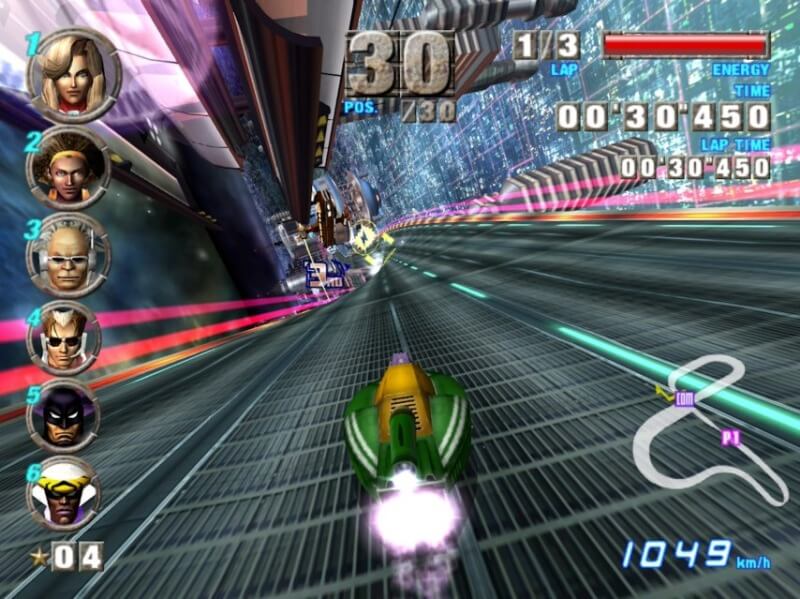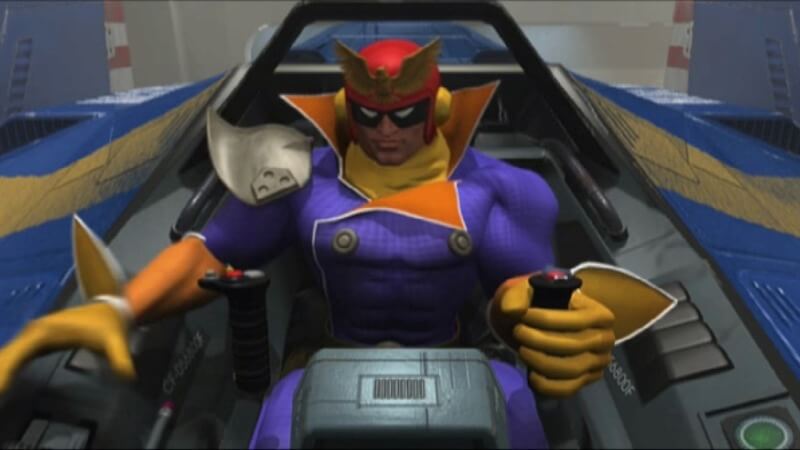F-Zero GX is one of the greatest games that Nintendo has ever released, and one of the greatest racers from anyone, period. No caveats needed, just the facts: it’s a stellar achievement made possible by the combining of Nintendo’s prodigious talent in this arena along with Amusement Visions, the internal Sega studio headed up by Toshihiro Nagoshi.
Nagoshi’s credentials should be familiar, but just in case: his career started at Yu Suzuki’s AM2 studio, where he was the designer on Virtua Racing, director of Daytona USA, director and producer of Shenmue, and then, after the founding of Amusement Visions, the creator of Super Monkey Ball and Like a Dragon/Yakuza.
This was not only the joining together of former rivals Sega and Nintendo for a project—one that Nagoshi and Shigeru Miyamoto had hoped would someday happen before Sega had even retired from console manufacturing—but it also involved Sega’s other rival, from the arcade side: Namco. The three companies all partnered together to create the Triforce arcade board, which was basically a souped up GameCube, and it ran the arcade version of F-Zero GX, known as F-Zero AX, as well as various Virtua Striker games and the Namco/Nintendo-developed Mario Kart GP games.
Basically there’s no reason to have ever believed that a game like this would have existed. Namco and Sega had been trying to one-up each other for even longer than Nintendo and Sega had, with their feud in the arcades spilling over into the console side when Namco partnered with Sony for the Playstation, leaving their prior partner—the one they essentially invented the concept of “third-party studio” with, Nintendo—behind in the process. All three joining forces might not seem so odd now in a world where something like Project X Zone 2 exists, in one where Sega has been a third-party developer longer than they were in the console business, but in the early aughts? Inconceivable.
All of which must be why Nintendo eventually decided that F-Zero GX maybe shouldn’t exist, after all. The game was successful when viewed through the right lens—a first-party racer that sold 1.5 million copies worldwide isn’t exactly going to be confused for Mario Kart 8 Deluxe—which is to say once you remember that the GameCube ended up in under 22 million homes. Still, it didn’t move the needle in the same way that the non-deluxe version of Mario Kart 8 did for the Wii U.
While it has been quite fairly recognized as the logical endpoint of F-Zero as a concept—I once described F-Zero GX as feeling “like you’re trying to fly a fighter jet at full speed through a crowded mall,” and meant it as the highest possible praise—Nintendo didn’t bother to re-release it on the Wii like they did some other GameCube classics that deserved a second chance on a more popular console, such as Pikmin and Pikmin 2 or Donkey Kong Jungle Beat. Their rationale was that it wasn’t going to incorporate the same kind of motion controls and IR-pointer uses as those games had. And then the Wii U wasn’t backwards-compatible for GameCube games like its predecessor, and didn’t include them as a Virtual Console offering even though Wii games were, so by the time the Switch came around the world had suddenly gone an entire decade and then some without easy access to F-Zero GX. That only continued with the Switch, as well, which means by the time 2025 rolled around it had been almost 22 years since F-Zero GX’s one and only official release. And that becomes a significant problem when you consider that there were only so many copies of the game out there… which is why it’s still going for an average price of over $80 secondhand in the present.

Nintendo finally stopped denying the existence of F-Zero GX with the launch of the Switch 2, however, as their newest platform introduced something people have been waiting well over a decade for: GameCube emulation. Now, longtime readers know how I feel about Nintendo Switch Online and subscription services for games in general—Virtual Console forever—but even longer-time readers might recall that my stance on what to do about the missing F-Zero GX, which was to put it in HD, add online multiplayer, and present it as-is in the present, with no additional courses or anything, just “F-Zero GX, in HD and with online play.” Thanks to some changes to NSO for its GameCube introduction, that’s exactly what happened. Being able to spend $20 on this would have been great, so that it’s not subject to being removed from a service someday, but this is still a pretty good result as far as these things go.
F-Zero GX is still fast, 22 years later. Impossibly fast. Its novice setting makes the introductory cup of Switch 2 launch exclusive Fast Fusion feel like you’re going backwards, and that’s a boost-heavy anti-gravity racer based on the legacy of F-Zero that has you going 500 mph. The GameCube emulation of the Switch 2 more than keeps up: it runs at a locked 60 fps, as the original did, and still looks great, as so many first-party GameCube games did. That little purple box hid some serious hardware inside of it, underneath a lot of jokes about how it was a system for babies whereas the Playstation 2 was for adults who were mature enough to imagine what kind of sex Kratos was having off-screen once they finished the minigame that triggered it.
The GameCube library is amazing. It doesn’t have the sheer numbers of the PS2’s, no, but nothing at the time did. The Cube was still loaded, and for whatever reason, Nintendo has only rarely revisited the games on it. There were those New Play Control remakes mentioned earlier, the occasional remake like Paper Mario and the Thousand-Year Door, but largely Nintendo has ignored that particular era in favor of mining the Nintendo 64 for remakes, or re-releasing Wii titles in some form. Where was Fire Emblem: Path of Radiance? Or the best Chibi-Robo game, Plug into Adventure? Or Custom Robo, or The Legend of Zelda: Four Sword Adventures, or Eternal Darkness: Sanity’s Requiem? Or… okay the entire article shouldn’t just be Remembering Some Games. But it could be!
It wasn’t just specific games that seemed to go to the GameCube and be trapped there, but even some series seem to have died after their GameCube entries. A supported NSO channel for GameCube games represents a chance to bring them back, in an emulated, upscaled capacity, and with online play where it fits. We haven’t had a new Wave Race since Blue Storm released on the Cube in 2001. No 1080° game since 2003’s Avalanche. Like with F-Zero GX, simply bringing those games back so they exist again anywhere would be worthwhile. Hell, even for series that haven’t disappeared, there’s utility in revival of old versions: if you miss the villagers being a little mean to you, the GameCube’s version of Animal Crossing would give you what you crave.
One thing that has stood out about the NES and SNES selections on Nintendo Switch Online to this point is that they have been, after the most obvious picks, full of some weirdos—curios, rarities, straight-up oddballs, but often interesting for one reason or another, and worth experiencing. The GameCube can easily pull this off, as well. Doshin the Giant is a Nintendo-published god game that was never released in North America. Geist was an M-rated game developed by n-Space and published by Nintendo that Miyamoto advised on, and while it didn’t quite stick the landing, it’s perfect for NSO as something you can just load up to see what the deal is, as part of an existing subscription. Treasure’s Wario World isn’t as good as the Wario Land entries, sure, but it’s also Treasure’s take on Wario, and wonderful enough for that. Also it usually goes for at least $100 secondhand these days. There’s Cubivore: Survival of the Fittest, developed by Saru Brunei and Intelligent Systems, and published by Nintendo in Japan, but Atlus in North America, in which you are attempting to birth cube-shaped offspring powerful enough to defeat the great evil tormenting the land, which they will do by tearing limbs off with their teeth. Odama! There’s a game that deserves a second chance—a collaboration between Seaman’s Yoot Saito and Nintendo, where you use a microphone to command your soldiers to move out of the way of the enormous pinball being used to destroy your enemies. Yeah, NSO that one up, please.
It’s not just Nintendo-published oddities that merit another look in the present, though. Capcom’s P.N.03 was derided for what it wasn’t, but what it is happens to be a ton of fun. Unburdened from an MSRP, people might actually notice as much. Put FromSoftware’s Lost Kingdoms and Lost Kingdoms II on NSO, so more people are aware that, before they started making Souls games, they were releasing deck-building action RPGs. Bomberman Generation, one of the absolute best games from that series, was a GameCube exclusive and has remained such. Sega’s Phantasy Star Online Episode I & II ruled on the Cube even when you didn’t have access to the internet to actually make it online. Like with F-Zero GX, that can be incorporated into it in the present—and don’t forget another card-based oddity that only released on Nintendo’s little box, Phantasy Star Online Episode III.
This is far from comprehensive, but you get the idea. The GameCube had legit hits, it had ambitious weirdos even in established franchises, it had straight-up oddities that many people still don’t know ever existed, and almost the entire run of them has been missing since Nintendo moved on to the Wii in 2006. Nintendo Switch Online adding GameCube support is the possible start of the change of all of that: even if not everything makes its way there, as it hasn’t with NSO’s NES and SNES libraries, it should still shine a light on some unfairly forgotten or never-known games. Just as F-Zero GX can now reel you in even if it’s not a shiny new launch game for the Switch 2, Nintendo can now give all the overlooked GameCube misfits of the world a second chance.
Marc Normandin covers retro videogames at Retro XP, which you can read for free but support through his Patreon, and can be found on Twitter at @Marc_Normandin.

